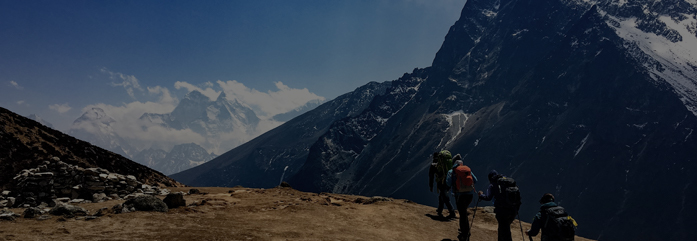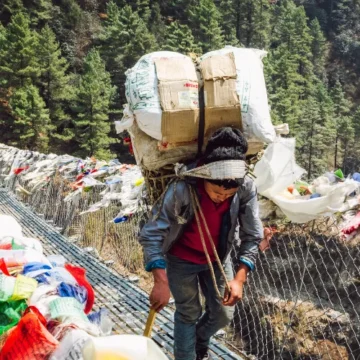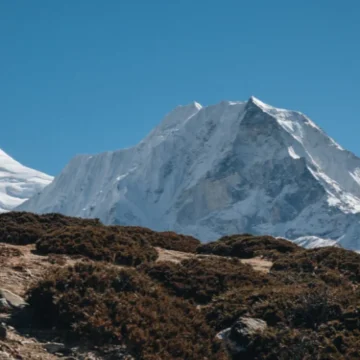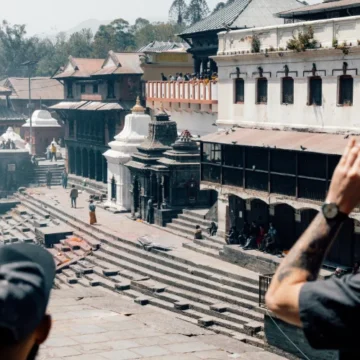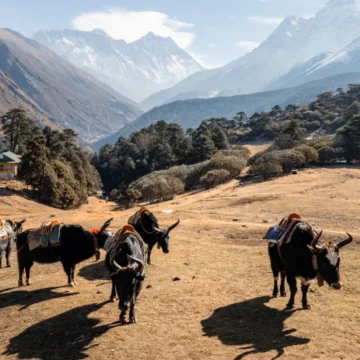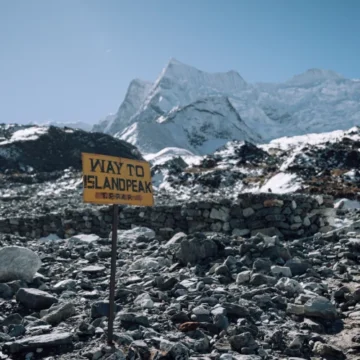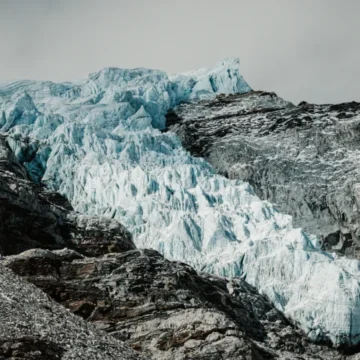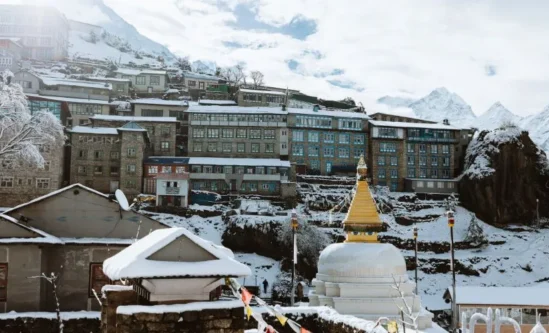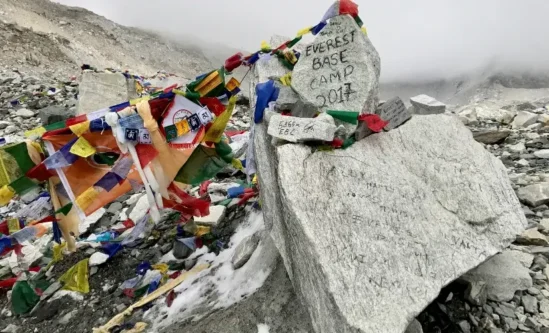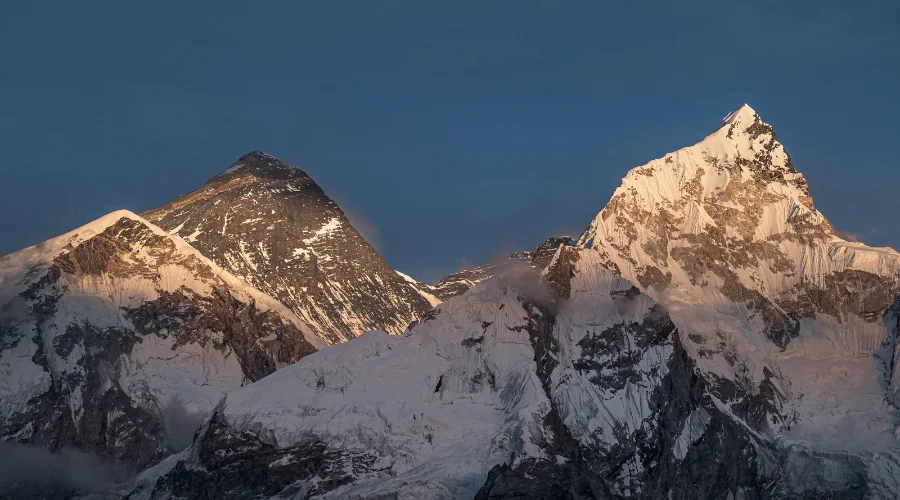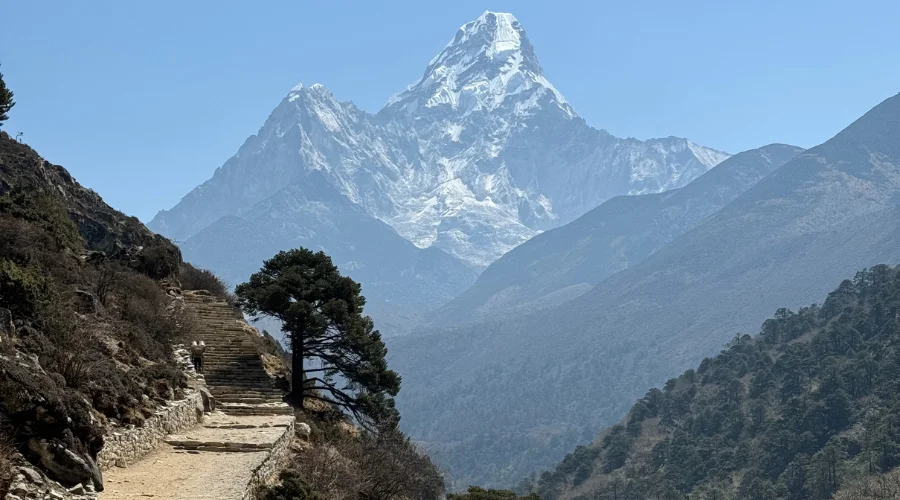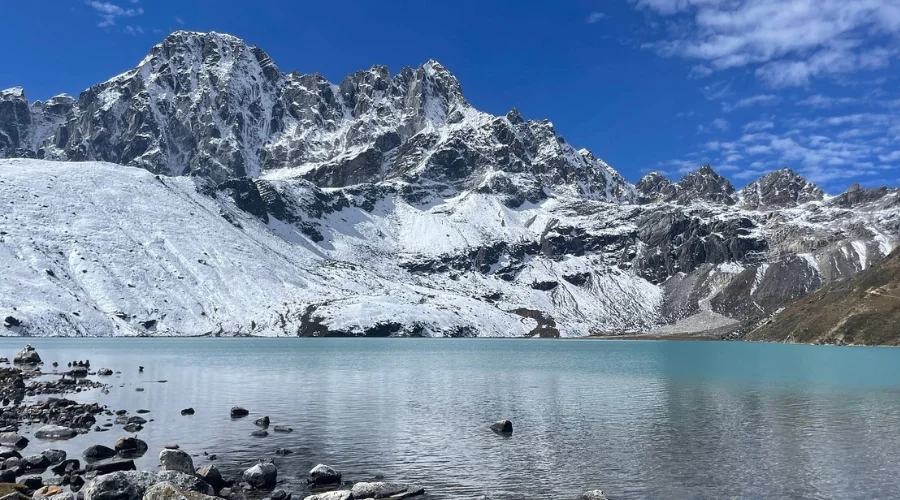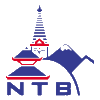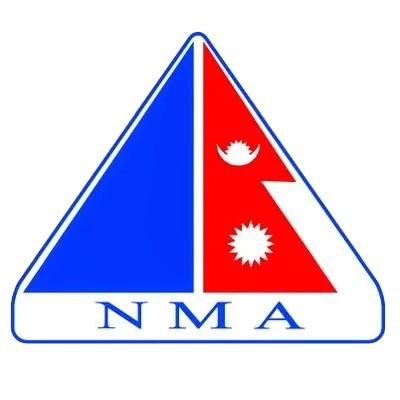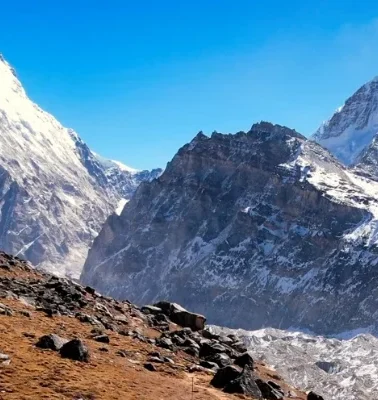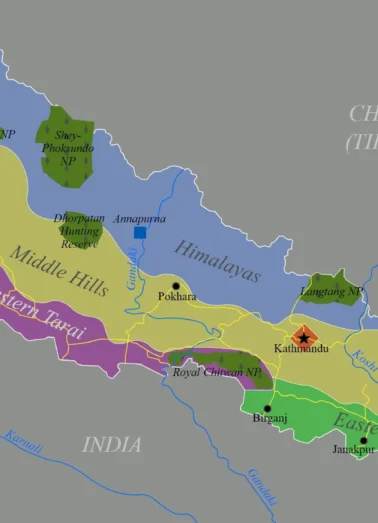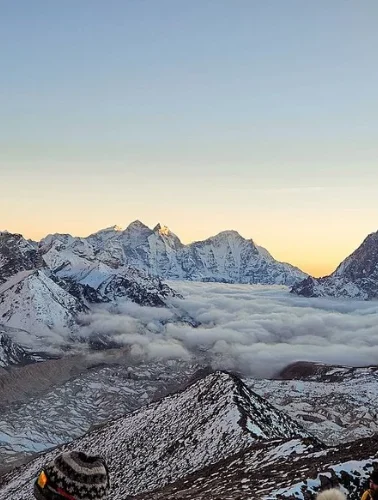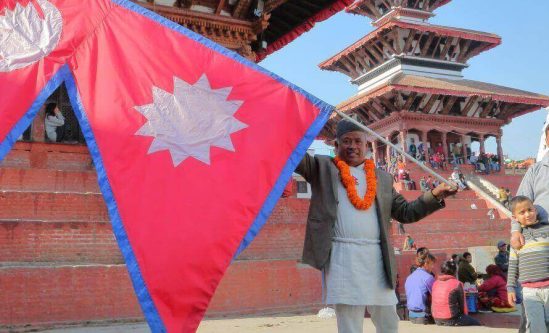
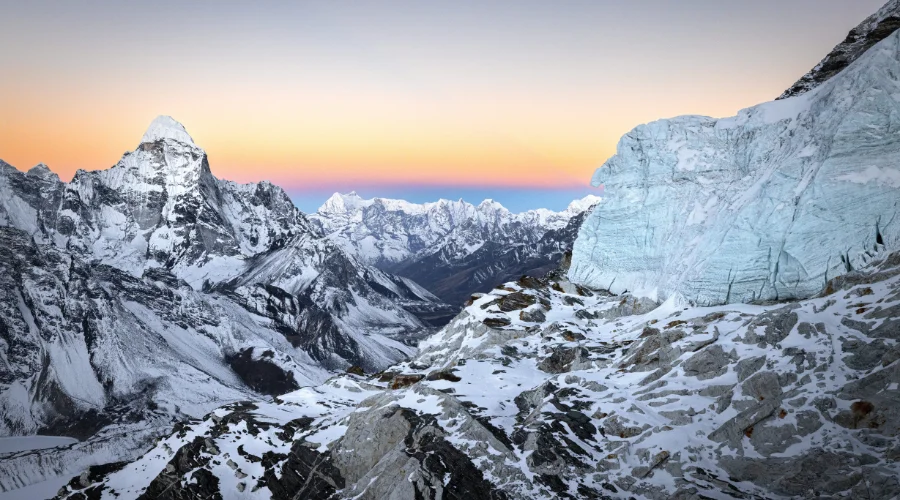
- TRIP DURATION
- 16 Days
- MAX. ALTITUDE
- 6,189 meters (20,305 ft)
- TRIP GRADE
- Difficult
- LODGING
- Hotel/ Lodge/ Teahouse/ Tent
- BEST SEASON
- Spring and Autumn
- MEALS
- Breakfast, Lunch and Dinner
- COMMUNICATION
- Local Sim, Wi-Fi
- PER DAY WALK
- 5-7 hours
Everest Base Camp Trek with Island Peak Climbing
Everest Base Camp Trek with Island Peak Climbing is an appropriate choice for trek and mountaineers since it is one of the majestic peaks of the Himalayas. On this combo trip, you will visit the stunning Khumbu region through a Sherpa village and a holy monastery and view the spectacular scenery that is attracting you.
Everest Base Camp Trek with Island Peak Climbing Overview
You will first arrive at Everest Base Camp (5,364 m), the base camp of every climber who practices the ascent to the Summit of Everest. Thousands of people dream of going to the foot of the highest mountain in the world, and this trek is part of that dream.
After leaving the Everest base camp, the trekkers trek to Kala Patthar, from which they can best view the summits of Everest, Lhotse, and Nuptse.
The next stage of the Everest Base Camp Trek with Island Peak Climbing involves climbing Island Peak (6,189 m), a technical and Nepalese classic peak. Here, you are equipped with climbing equipment (ropes, ice axes, crampons) and accompanied by seasoned climbers.
Landing on the Island Peak Summit is tiring but incredible. You will get the breathtaking views of Everest, Makalu, and other Himalayan peaks.
Everest Base Camp Trek with Island Peak Climbing is a perfect option for those who wish to test their limits by trekking, climbing, and admiring the power of the Everest region.
It provides an adventure, cultural, and natural beauty mix. The walk normally lasts 16 days, with a flight to Lukla and follows the main trail from Everest Base Camp to Island Peak.
However, the EBC Trek with Island Peak finishes with another downhill run back to Lukla and flights back to Kathmandu. This trip is right up for people who like to challenge their climbing skills and get a thrill up at majestic heights.
Everest Base Camp Trek with Island Peak Climbing Highlights
- Fly to one of the most thrilling airports, Lukla Airport.
- Walk through the Sherpa Villages and explore the settlements.
- Experience Sherpa culture, Buddhist monasteries, and traditional mountain villages.
- Trekking in the picturesque Sagarmatha National Park, a UNESCO World Heritage site.
- Breathtaking views of Everest, Lhotse, Nuptse and Ama Dablam and scale peaks in the Himalayas.
- Reach Everest Base Camp at a height of 5364 meters.
- Hike to Kala Pathhar to see the majestic view of Mount Everest.
- A climb of Island Peak (6,189 m), an iconic, beautiful, alpine mountaineering experience in Nepal, for mountaineer initiation.
Everest Base Camp Trek with Island Peak Climbing Route
Kathmandu – Lukla – Phakding – Namche Bazaar – Tengboche – Dingboche – Lobuche – Gorakshep – Everest Base Camp – Gorakshep – Kala Patthar – Dingboche – Chhukung – Island Peak Base Camp – Island Peak Summit – Base Camp – Chhukung – Tengboche – Namche Bazaar – Lukla – Kathmandu
Why Choose Everest Base Camp Trek with Island Peak Combo?
This Everest Base Camp Trek with Island Peak is a dream come true for anyone who wants to trek and climb the Everest zone. It allows you to travel to the popular Everest Base Camp and attempt to climb one of the peaks of the Himalayas.
The Everest Base Camp Trek with Island Peak is tough, but the experience is rewarding. It stimulates a sense of success and provides breathtaking mountain views.
Climbing Island Peak and trekking together as one adventure is appropriate for those wanting to prepare for the next level of more demanding climbing activity.
Experience, acclimatization, a seasoned leader and preparation will all lead to positive results for this expedition, an adventure of hardship and the sublime beauty of the Himalayas.
What’s the challenge of EBC with Island Peak Trek like?
The Everest Base Camp Trek combined with island peak mountaineering is an adventure in its own right, requiring a mix of at least some physical and mental strength.
The route is of a regular medium grade of difficulty of Island Peak, consisting of a long-distance walk, high elevation, hills, and stairs. However, it is a different challenge since climbing Island Peak is not dissimilar to climbing to, e.g., Island Peak—sites are technically demanding with ice and snow.
Climbers carry mountaineering gear, such as crampons, ropes, ice axes, etc. Climbing expertise is not required, but having some experience using climbing gear is desirable.
The major challenges are altitude sickness, precipitation, and height. Up to 5,550 m, Kala Patthar and 6,189 m Island peak end of the route.
Another major challenge comes when you start climbing the Island Peak. The route of Island Peak up to the crampon point is good to go. But once you reach the Crampon Point at Island Peak, you will begin the real climbing.
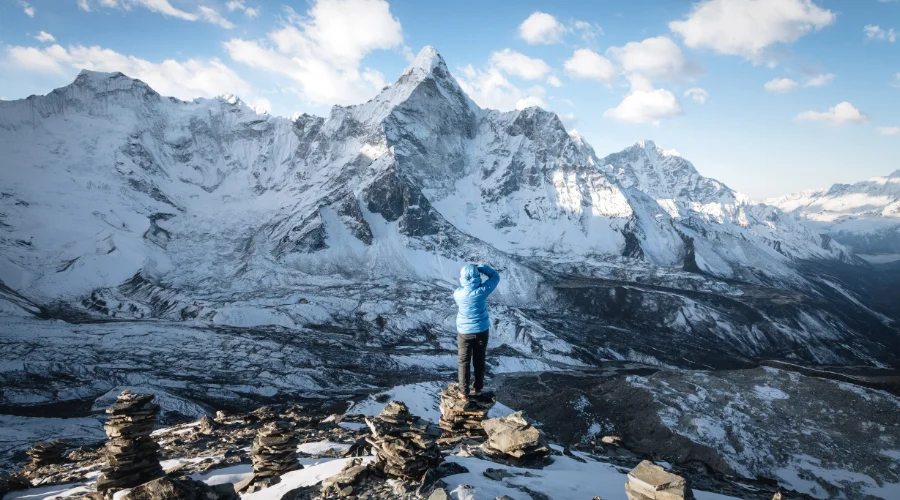
The climb from the Island Peak crampon point to the summit is approximately 90 degrees inclined. From this point, one must wear climbing equipment fully.
Acclimatization is crucial to avoid altitude-related problems. The climb is on ice and on a rope ladder, with crevasse crossing and slope rope ladders.
Fitness and experience in such types of treks generally allow people to succeed on the climb as long as proper preparation is undertaken.
Island Peak Climbing Stages from Base Camp to Summit
To climb Island Peak in Nepal you will need to cross these various stages from the base camp to Island Peak Summit. Make sure you take each and every detail for successful Island Peak Summit.
Island Peak Base Camp (5,087 m) to High Camp (5,500 m)
The hike from the Island Peak Base Camp to High Camp is short and extremely inclined. It takes around 2 to 3 hours. The trail is not on a flat surface; there are some rocks that are not very comfortable to step down.
There is a site from which someone can stand/climb upon which climbers have been known to feel the physiological sensation of high altitude (slow walking and drinking the requisite potable) and, hence, is, accordingly, recommended.
At High Camp, climbers receive camp rest by sleeping in tents and loading gear using a climbing rope and ice axe technique. This is the terminal position (i.e., the point at which the descent to the summit is completed).
High Camp to Crampon Point (5,800 m – 5,900 m)
The climb from High Camp starts at daybreak, usually at 2 AM. The path is steep, and ropes are needed for the ascent’s safety. Following a walk, they arrive at Crampon Point one and a half to two hours later.
When climbers are required to ascend on ice and snow, they are provided with crampons (metal nails attached to boots) to traverse icy and snowy terrain.
This climb stage is long and laborious, and climbers always try to determine the length of their steps.
Crampon Point to the Glacier (6,000 m)
The way follows the glacier after the crampons are applied. This is where the real ice climbing begins. On this glacier, climbers are very careful, following their guide’s pace on the lead and avoiding stepping on collapsed crevasses (ice fractures).
The view is stunning, with snow-covered peaks all around. The wind is quite powerful, and taking a breath is very difficult because it is high. Anchors with multiple leverage points create movement for climbers.
Glacier to the Headwall (6,050 m – 6,100 m)
Immediately following is the challenge of crossing the glacier and accessing the Headwall. That is a nearly vertical ice wall, along which are slung together climbers to climb using rope, ice axe, and jumar, a device that serves as a climbing rope attachment.
The Headwall is the scariest climb due to its extreme vertical, intense climbing feature. Climbers are painstaking and take one step after another, during which weight is placed onto the wall with an ice axe.
Headwall to the Summit Ridge (6,100 m – 6,160 m)
After climbing the Headwall, climbers reach the summit ridge. This steep, unprotected ridge is covered with snow. It’s a wonderful view, but the sheer rock faces on either side are quite otherworldly.
Climbers must walk carefully, holding onto the ropes. The summit ridge is one of the strenuous parts of the climb, and it offers views of Everest, Lhotse, and other Himalayan mountains.
Summit Ridge to the Island Peak Summit (6,189 m)
Finally, there is a steep ascent to the summit. Hypoxemia is a barrier to aspiration, and they push their limits to their maximal to reach the peak. Gradually, they came to a halt and stood at the top of Island Peak.
The view is nice, and there is also an excellent giant forest view of the wooded hills. Climbers compare photos, rove, climb, and walk into walls.
Descent from the Summit to Base Camp
Going down is faster but still challenging. At the Headwall, climbers descend the Headwall and then, with slow glacier flow, ascend back to High Camp. After some rest, we descend further to Base Camp. The ending ascent from High Camp to the top and back takes about 10 to 12 hours.
Benefits of Booking with Himalayan Masters Adventure
- Free Luggage Storage for extra bags during the trek.
- Complimentary Gear like Sleeping bags, down jackets, trekking poles, and water treatment tablets.
- Himalayan Masters Brand T-shirt and cap.
- Experienced guides for climbing Sherpas provide support on the back end and summit achievement.
- Flexible Itinerary to accommodate acclimatization needs.
- Small Group Size for personalized service.
- 24/7 support before and during the trek.
- Eco-Friendly Approach with responsible trekking policies.
- Assistance with Permits and Documentation for a hassle-free experience.
- Some other useful travel guides to Everest Base Camp Trek and Island Peak.
The 16 Days Itinerary Outline of EBC Trek with Island Peak
| Day | Route | Time | Sleep Altitude |
| 01 | Kathmandu → Lukla → Phakding | 3.5-4.5 hours | 2610 m |
| 02 | Phakding → Namche | 6-7 hours | 3440 m |
| 03 | Namche → Hotel Everest View → Namche | 3-4 hours (round) | 3440 m |
| 04 | Namche → Tengboche | 5-6 hours | 3860 m |
| 05 | Tengboche → Dingboche | 6-7 hours | 4410 m |
| 06 | Dingboche → Nagarjuna Hill Top → Dingboche | 5 hours (round) | 4410 m |
| 07 | Dingboche → Thukla Pass → Lobuche | 6-7 hours | 4910 m |
| 08 | Lobuche → Gorakshep → EBC → Gorakshep | 9-10 hours | 5140 m |
| 09 | Gorakshep → Kala Patthar → Gorakshep → Dingboche | 7-8 hours | 4410 m |
| 10 | Dingboche → Chhukung | 3 hours | 4730 m |
| 11 | Chhukung → Island Peak Base Camp | 4 hours | 5080 m |
| 12 | Island Peak Base Camp → Island peak → Base Camp/ Chhukung | 10-11 hours | 5080 m |
| 13 | Island Peak Base Camp/ Chhukung → Dingboche | 3 hours | 4410 m |
| 14 | Dingboche → Namche | 7-8 hours | 3440 m |
| 15 | Namche → Phakding → Lukla | 5-6 hours | 2840 m |
| 16 | Lukla → Kathmandu | 25 min | 1400 m |
ITINERARY
Day 01: Fly from Kathmandu to Lukla and Trek to Phakding
We fly by air early from Kathmandu to Lukla via flight of 25 min. The flight from Kathmandu to Lukla is really thrilling.
Lukla is an access point to Mount Everest and Sherpa and trekking community. After landing, we start our trek towards Phakding. The trail descends into a green forest and rarely crosses villages like Chheplung and Ghat.
We walk along the Dudh Koshi River and let the ropes of several suspension bridges play with us.
The trail is up to 3.5-4.5 hours long and mostly downhill or flat, making it a good starting point for a day hike. We stay overnight at Phakding.
Meal : Breakfast, Lunch and Dinner
Accommodation : Luxury Lodge
Walking / Driving : 25-30 min Flight & 3-4 Hours Walking
Day 02: Trek from Phakding to Namche Bazaar
After breakfast, we walk on the Dudh Koshi River and along the suspension bridges, the highest level, perhaps the most popular one, being the Hillary Suspension Bridge.
The way progresses through peaceful villages (e.g., Monjo, Jorsalle) and ends up in the heart of Sagarmatha National Park. Here, we get our permits checked.
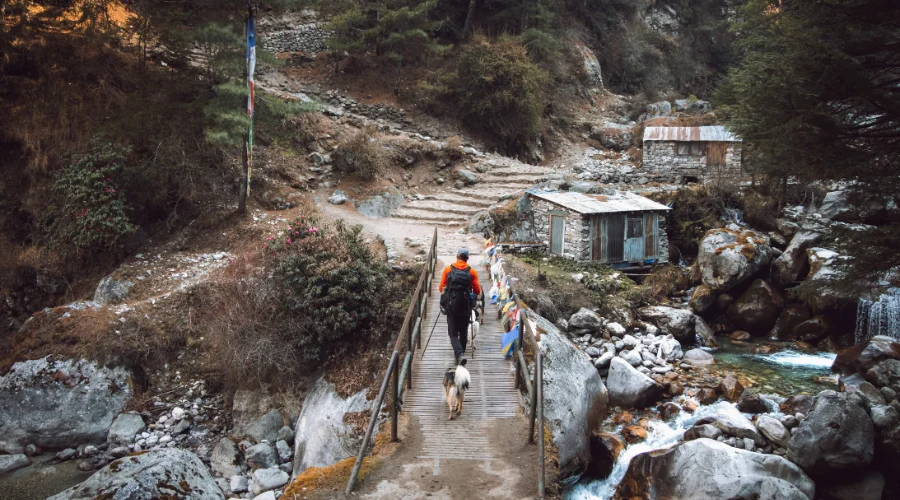
This is a long and tiring day, the main requirements of which are between 6 and 7 hours. Extending to a climb in altitude, we find the first view of large mountains surrounding us.
Finally, we arrive at Namche Bazaar (3,440 m), the highest Sherpa village in the Everest region.
Meal : Breakfast, Lunch and Dinner
Accommodation : Luxury Lodge
Walking / Driving : 6 to 7 Hours (Walking)
Day 03: Acclimatization in Namche – Hike to Hotel Everest View
On acclimatization day, we walk around for a couple of minutes and come out for those minutes. We reach Hotel Everest View, a 1.5 hour uphill walk.
As one of the tallest hotels in the world, this hotel gives views of Everest, Lhotse, Ama Dablam, and other peaks.
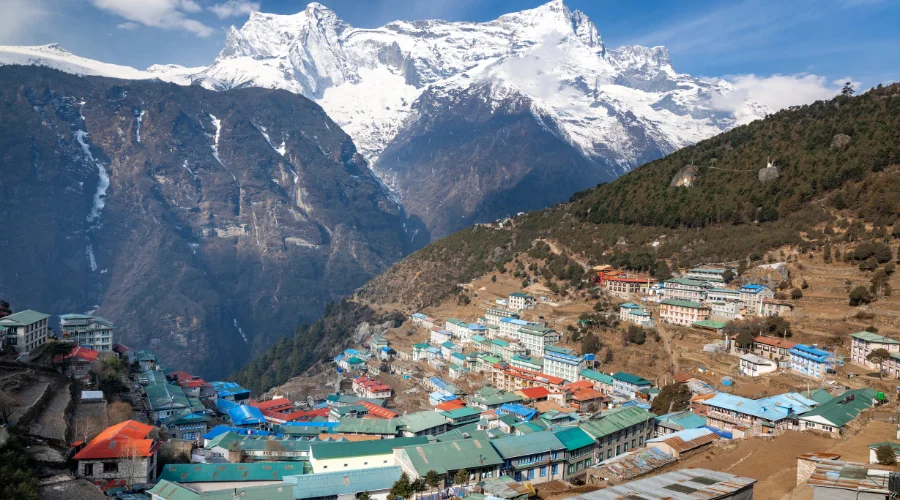
Next, we see the Syangboche airstrip and Khunde village. After enjoying the views, we descend back to Namche.
The round trip takes about 3-4 hours. We also visit Namche Bazaar, shops, bakeries, and the Sherpa Museum in the late afternoon.
This is a nice place to study Sherpa culture and climbing history on Mount Everest.
Meal : Breakfast, Lunch and Dinner
Accommodation : Luxury Lodge
Walking / Driving : Around 3 Hours Walking
Day 04: Trek from Namche Bazaar to Tengboche
We go to Namche and then follow the route from Namche to Tengboche.
At the beginning of the trail, the way is relatively easygoing, as we are on a wide ridge with an amazing panorama of Everest, Lhotse, and Ama Dablam.
We follow the trail from the small villages of Kyangjuma and Sanasa up to Phunki Tenga. It is an extremely tiny location on the banks of the Dudh Koshi River, on which we load and unload at lunch break.
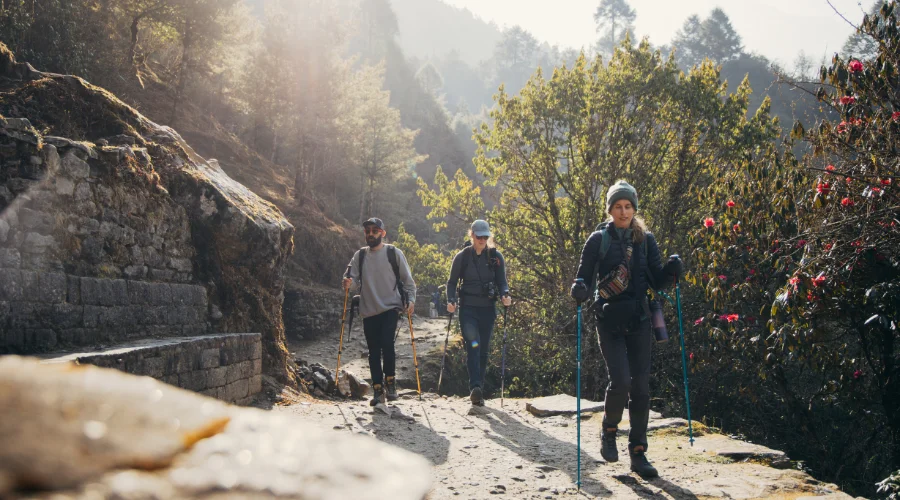
Following Phunki Tenga, the path is steep and rocky as we climb through thick rhododendron forests. After 5 to 6 hours of hiking, we’re there, Tengboche.
Specificity, however, is perhaps the most striking feature of all the monasteries in the Everest region, including the Tengboche Monastery.
It is also advisable to remain in that space during nighttime hours, visiting the monks’ prayer service to experience a peaceful atmosphere.
Meal : Breakfast, Lunch and Dinner
Accommodation : Teahouse
Walking / Driving : 5 to 6 Hours (Walking)
Day 05: Trek from Tengboche to Dingboche
The day begins in pine and rhododendron woods. After walking across a suspension bridge over the Imja Khola River, we are in the village of Pangboche.
This is one of the old Sherpa villages in the region, a considerable distance from another good monastery.
However, as we move along the route, the number of houses decreases, and thus, we observe more open hills and rough roads.
We walk by Somare and Orsho before arriving at Dingboche (4,410 m) after 6 to 7 hours of walking.
Dingboche is an area of stone houses with a stunning view of the mountains, including Ama Dablam.
Meal : Breakfast, Lunch and Dinner
Accommodation : Teahouse
Walking / Driving : 6 to 7 Hours (Walking)
Day 06: Acclimatization Day – Hike to Nagarjuna Hill
We make a short acclimatization trek to Nagarjuna Hill to acclimate to a high altitude.
The trek is about 2.5 hours long, and there are great views of Makalu, Lhotse, Ama Dablam, and Island Peak. The trail is quite steep and rough, which is not a comfortable effort, as one can enjoy the view after climbing.
After staying at a remote place and admiring the views, we will return to Dingboche, and the journey will take about five hours.
Meal : Breakfast, Lunch and Dinner
Walking / Driving : Around 5 Hours Walking
Day 07: Trek from Dingboche to Lobuche via Thukla Pass
Today, we continue our journey toward Lobuche. The route begins with a little ascent and easy walking around the wide basin.
As we reach the Thukla (Dughla) 4830 m/ 15846.5 ft and take a short break for ourselves, a lot of this is emotionally overwhelming since it is the climber’s memory of those who died while climbing Everest.
When the pass is crossed, the ground tends to be flatter, and there is a gradual incline towards Lobuche.
The total trek takes about 6 to 7 hours. Lobuche is a small teahouse area, just a few rooms at the base of the slopes of one of the giants of the mountains.
Meal : Breakfast, Lunch and Dinner
Accommodation : Teahouse
Walking / Driving : 6 to 7 Hours (Walking)
Day 08: Trek from Lobuche to Everest Base Camp (and back) and Gorakshep
This is the most exciting and difficult day on the trail. We reach early and thus walk three long distances to Gorakshep (5,140 m), the highest village before Everest Base Camp.
We then begin the trail to Everest Base Camp. We reach the base of the highest mountain in the world (5,364 m), and as we approach, we see colourful prayer flags and expedition camps.
We will click some extra photos being excited at the base camp of the world’s highest peak.
After enjoying a while at the base camp, we will return to Gorakshep.
Meal : Breakfast, Lunch and Dinner
Accommodation : Teahouse
Walking / Driving : 9 to 10 Hours (Walking)
Day 09: Trek from Gorakshep to Kala Patthar sunrise to Dingboche return
We go to bed very early due to the schedule of being able to go to Kala Patthar (5550 m) and watch the sunrise. This is the summit of our Everest Trek, which is the highest and clearest view of Mount Everest.
The climb is steep and takes about 2 hours, but the view of the sunrise from above over Everest, Nuptse, and other peaks is magnificent.
This is where your dream comes true! You will see the majestic view of the highest mountain in the world, Mount Everest. You will click some amazing photos and be amazed by the view of the highest peak.
From here, we trek back down to Dingboche, passing through Lobuche and Thukla Pass again. The return journey takes about 7 to 8 hours.
Meal : Breakfast, Lunch and Dinner
Accommodation : Teahouse
Walking / Driving : 9 to 10 Hours (Walking)
Day 10: Trek from Dingboche to Chhukung
Trekking is less than yesterday and relatively easy here at Chhukung.
The trek today is a piece of cake and takes the route of Imja Valley, with amazing views of Ama Dablam, Lhotse, and Island Peak. We trek for 3 hours through the high alpine yak meadows to Chhukung.
Chhukung is a tiny village comprising two tea houses, mostly used as a base camp for Island Peak climbers.
Subsequently, we check the climbing gear’s field suitability and ensure that it is in good condition for field climbing.
Meal : Breakfast, Lunch and Dinner
Accommodation : Teahouse
Walking / Driving : 3 hours (walking)
Day 11: Trek from Chhukung to Island Peak Base Camp & Pre-Climbing Training
Today we have the next trek to Island Peak Base Camp is crossed on a heavily rocky and glacial path.
However, due to the glacial water regime, the path is soft sediment and has a landslide risk in relation to glacial flow.
The trek takes around 4 hours. The closer we are to the base camp, the more the area becomes dry ground with an ice slope in the background.
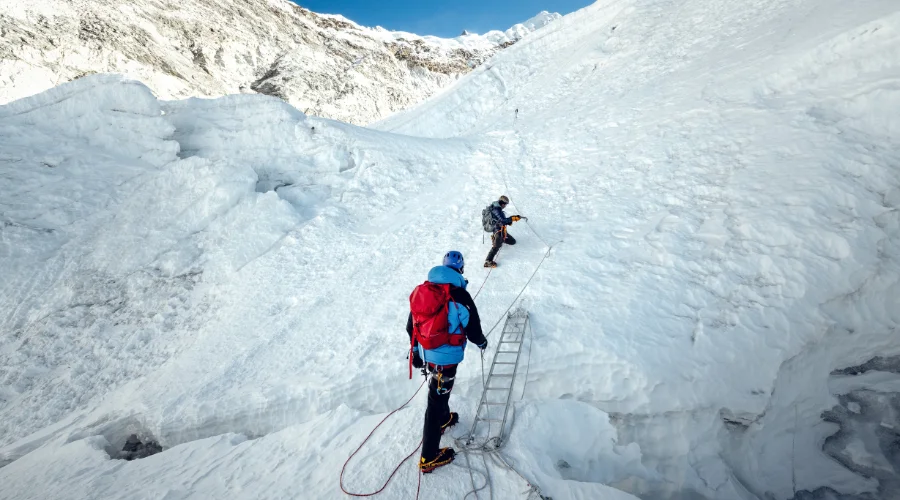
Since rest and coaching for climbing take place in base camp, we go for it in the evenings. Our climbing guide indicates the application of crampons, ropes, axes, and a harness on the peak’s top.
This training is essential for the absolutely novice and/or very inexperienced mountaineer. The Himalayan Masters team climbing guide will help you have the best summit tomorrow. They will guide you with everything required for the summit day.
Meal : Breakfast, Lunch and Dinner
Accommodation : Tents at Base Camp
Walking / Driving : 4 hours (walking)
Day 12: Island Peak Summit Return to Base Camp or Chhukung
Today is the most difficult of Island Peak Climbing but the most rewarding day of the trail to get here. We will begin scaling before midnight if we are at 1–2 AM.
An early push is advantageous to avoid rapidly changing cold afternoon wind at the summit. The ascent starts on a rocky, steep trail to the glacier. We have both crampons and fixed ropes for protection in this setting.
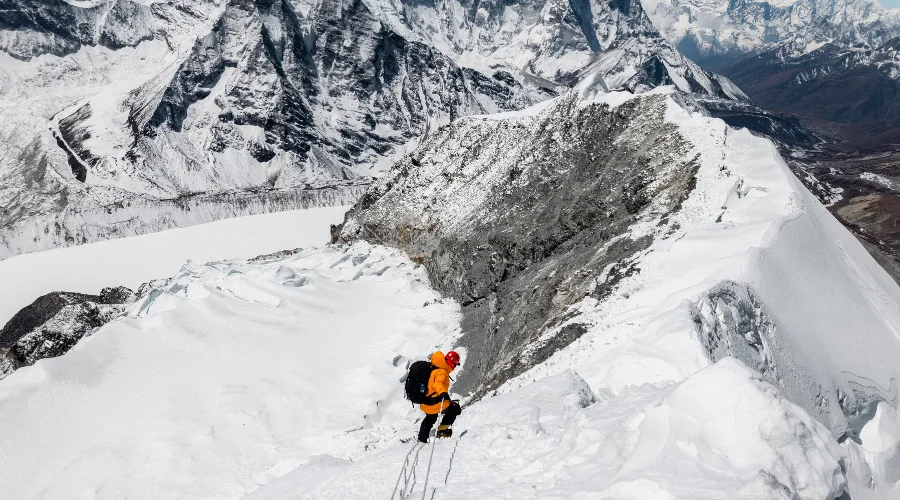
The final one is an iced ramp leading down to the very steep ramp at the top (6,189 m). Below us lies the spectacular scene of Everest, Lhotse, Nuptse, Makalu, and Baruntse.
We eventually camp out for some time at one of the two points known as base camp, which we reach in 10-11 hours total, and Chhukung, where we spend the night as part of the trek.
Meal : Breakfast, Lunch and Dinner
Accommodation : Tent/ Teahouse
Walking / Driving : 11 hours (walking)
Day 13: Trek from Island Peak Base Camp/Chhukung to Dingboche
After our amazing summit attempt, we head back down. The trek starts at the Island Peak base camp in the morning, and we return from Chhukung camp (4,730 m) for three hours.
From Chhukung, we proceed downhill to Dingboche (4,410 m), where we walk through familiar scenery and along yak pastures.
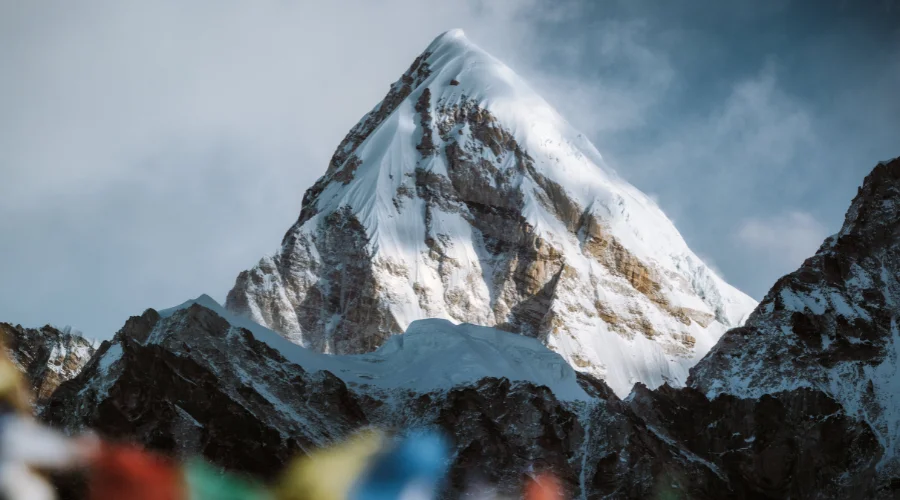
The walk from Chhukung to Dingboche on the route is about 3 hours. It’s got to be a gruelling trek for someone to do; we shall be able to rest and relax in Dingboche.
Meal : Breakfast, Lunch and Dinner
Accommodation : Teahouse
Walking / Driving : 3 hours (walking)
Day 14: Trek from Dingboche to Namche
On this day, we trek from Dingboche to Namche Bazaar which takes 7 to 8 hours.
The route is downhill, in the same direction, and at the top, it is the same route as before. From the summit, we travelled to Pheriche and Tengboche.
We walk over suspension bridges, towns, and Lhotse and Ama Dablam views.
Nearest to Namche, the view goes back to a highly vegetated scene and changes in view altitude from the previous scenes.
You can rest your body fully today in Namche at the luxury lodge. You can also get a full body massage or sauna to relax your body.
Meal : Breakfast, Lunch and Dinner
Accommodation : Luxury Lodge
Walking / Driving : 5 hours (walking)
Day 15: Trek from Namche to Lukla
On the last day of the trail, we have our final, optional walk down to Lukla (2,860 m), with breaks, and we return walking.
The trail eventually enters the pine and rhododendron forest, where the expanse of the Khumbu is seen from a scenic vantage point with spectacular views.
We follow the route to the small villages of Phakding and Jorsalle, cross the Dudh Koshi, and finally return to Lukla.
Meal : Breakfast, Lunch and Dinner
Accommodation : Luxury Lodge
Walking / Driving : 6 hours
Day 16: Fly from Lukla to Kathmandu
Today marks the end of our amazing Everest adventure. We will fly for 25 minutes from Lukla to Kathmandu.
You will find yourself in the crowd again after returning from the peaceful trails of the Everest region. You have the option of visiting and exploring the Kathmandu valley and surroundings and short hikes too.
Meal : Breakfast
Accommodation : Hotel (Not Included)
Walking / Driving : 25-30 min flight
Fixed Departure
| Trip Date | Trip Status | |
|---|---|---|
| 01-03-2026 | OPEN | book now |
| 04-03-2026 | OPEN | book now |
| 08-03-2026 | OPEN | book now |
| 14-03-2026 | OPEN | book now |
| 19-03-2026 | OPEN | book now |
| 24-03-2026 | OPEN | book now |
| 31-03-2026 | OPEN | book now |
| 05-04-2026 | OPEN | book now |
| 09-04-2026 | OPEN | book now |
| 19-04-2026 | OPEN | book now |
| 23-04-2026 | OPEN | book now |
| 28-04-2026 | OPEN | book now |
| 04-05-2026 | OPEN | book now |
| 09-05-2026 | OPEN | book now |
| 14-05-2026 | OPEN | book now |
| 18-05-2026 | OPEN | book now |
| 21-05-2026 | OPEN | book now |
| 25-05-2026 | OPEN | book now |
| 28-05-2026 | OPEN | book now |
include / exclude
Trip Cost Includes
- Private car pickup and drop-off at all international and domestic airports.
- A professional English-speaking trekking guide during the trekking.
- Three nights accommodation in Kathmandu with breakfast (4-star hotel).
- Two nights in the Namche Deluxe Room with the heater blankets.
- A professional trekking guide for the entire trek.
- One Trekking porter for the entire (porter can carry up to 28 kg (One porter between two trekkers).
- 1 set breakfast, 1 set lunch, and 1 set dinner during your trek and expedition.
- Three cups of hot drinks (tea and coffee) a day.
- Lukla, Phakding, and Namche rooms with attached bathrooms and hot showers.
- Three nights’ accommodation in Namche in a luxury lodge.
- Best available twin-sharing teahouse accommodations in the mountains.
- Sagarmatha National Park permits.
- Khumbu municipality permits.
- Island Peak climbing permits.
- Kathmandu to Lukla to Kathmandu airfare.
- Guide Flight Ticket.
- All government taxes and company service charges.
Complimentary services from Himalayan Masters
- Include a 25-degree sleeping bag during the trip.
- A 20-degree down jacket during your trip
- Check your spo2 and bpm with a pulse oximeter at high altitudes.
- Water bottles and purification tablets by Himalayan Masters
- first aid kit box.
- Seasonal fruits for dessert.
- Himalayan Masters Brand Duffle Bag for the Trip (Porter will carry the duffel bags) 8. Himalayan Masters Brand Trekking T-Shirt and Cap
Island Peak Climbing Costs Includes
- One-night or two-tent stay at the Island Peak base camp.
- Breakfast, lunch, dinner during base camp, and tea and coffee are unlimited.
- Climbing Sherpa to climb the Island Peak.
- All climbing gear during the Island Peak.
- Climbing permits for Island Peak.
- Climbing Guide Insurance.
- All necessary equipment for island peak climbing.
Trip Cost Excludes
- An international flight ticket.
- Tips for Trekking Guide Climbing guides and base camp cooks
- WiFi, battery charging, and hot showers after the Namche Bazaar.
- Travel Insurance.
- Your expenses.
Other things not mentioned above are also on the exclusion list.
useful info
Best time to do Everest Base Camp Trek with Island Peak Combo
The best time for Everest Base Camp trek with Island Peak Climbing is during the pre-monsoon (Spring) and post-monsoon (autumn) seasons.
Spring is a beautiful time (March to June) to visit, as the weather is not very cold, and the pavements are usually lined with flowering rhododendrons.
Spring is also considered one of the warmest times of the year to climb Everest Base Camp and Climb Mera Peak. The warm weather and Everest temperatures will help the trekkers have a warm trek with beautiful views of seasonal flowers.
The sky is blue, the landscape is beautiful, and the climbing conditions at Island Peak are very good. Mountaineers are set to attempt the ascent of Everest this climbing season.
Other times of the year, such as autumn (September and November), are also good times for activity. Winter has clear, cloudless blue skies after the monsoons, and the weather is ideal for flight. The air is very dry, so now is the best time to walk and climb.
It is reasonably mild at low elevations but much colder at high elevations at night. This climbing season also offers ideal conditions for other Island Peaks, with a lower probability of getting snow or strong wind.
Winter (December to February) is freezing, and monsoons (June to August) are rainy, so neither suits this trip.
What kind of permits do I need for Island Peak Climbing with EBC?
For the Everest Base Camp Trekking and Island Peak Climbing experience, in addition to obtaining the trekking permit, you are also required to obtain the climbing permit.
Sagarmatha National Park Entry Permit and Khumbu Pasang Lhamu Rural Municipality Permit are mandatory for all Everest region trekkers.
Island Peak Climbing Permits can only be obtained from the Nepal Mountaineering Association (NMA), so climbing Island Peak is restricted to NMA members.
The cost of Island peak Climbing can be affected by the season; the most expensive is spring, and the least expensive is winter.
It is also important to check the number of demand and rates during trip planning. It is generally recommended that you inquire about the current permit policy with a trekking agency like Himalayan Masters or Nepal Tourism Board.
Things to Remember While Preparing Packing
Here, one must be ready to prepare the equipment to integrate it into the Everest Base Camp Trek and Island Peak Climbing activity.
The equipment needed to go hiking is normal, including sturdy trekking boots, warm layers, a waterproof shell jacket, hiking sticks, gloves, sunglasses, and a backpack.
Layering has been of great concern because of the temperature change at the low and high levels.
To accommodate the cold teahouse nights, sleeping bags rated at -15 °C or below are necessary. Other relevant trekking gear includes a water purifier, sunscreen, a headlamp, and other essentials.
Specialized gear is required for the climbing section. You will need mountaineering boots that are acceptable for crampon use, a climbing harness, an ice axe, carabiners, and headgear.
Insulated gloves, thermal base layers, and winter coats are essential protective gear for withstanding cold weather.
There is rented equipment in Kathmandu or Namche Bazaar, but travelling with high-quality, well-fitting equipment is more convenient.
Some of the more significant aspects are to walk softly and not carry the pack, as it is easy to put too much weight on the shoulders, making the walk physically difficult.
You must have packed and checked out your gear to ensure that you have checked with your guide/trekking company that everything essential for the trek and the climb is supplied.
Accommodation and Food | What to Expect
Teahouses are the kind of accommodation you get and are run by families living in the local communities on the ascent to Base Camp at Everest. They have small but cozy rooms with twin beds and facilities for a shared toilet and bathroom.
Some tea houses in the lowlands offer hot showers, WiFi at the lowlands, and basic facilities in the highlands.
In Dingboche or Chhukung, before Island Peak, accommodation is easier to organize and supply for the connected facilities, including electricity or an internet connection, maybe at times.
There are no tea houses at Island Peak Base Camp’s lower base camp, so climbers are forced to spend the night in the trekking agency’s tents. Camping tents provide sleeping pads, and expedition members cook food.
Trekking food is easy to cook and nutritious. It mainly consists of dal bhat, noodles, soup, momo, pasta, and eggs. Teahouses also offer porridge, toast, and tea for breakfast.
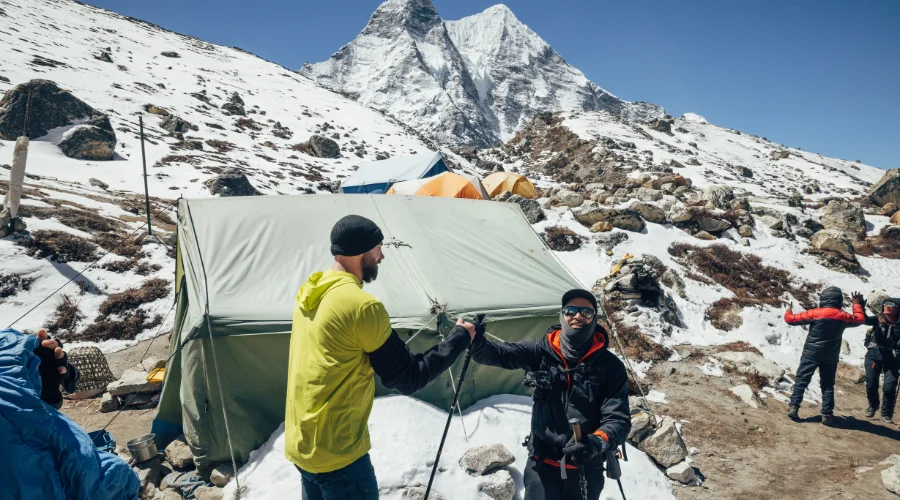
Food choice is restricted at altitude, i.e., to the top of an altitude range and also at the cost of transport being restricted by cost.
Island Peak Base Camp kitchen provides nutrition for the climbing team, high-calorie, high-energy foods, and is designed for endurance.
Altitude increases, and their related hypoxia, respiration, oxygen, and hypovolemia should be managed, and alcohol should be avoided, as both medications, alone, increase the risk of altitude sickness.
Trip Grade: Fitness Level, Medical & Health
The Island Peak Climbing trail is very fatiguing, requiring a high level of physical fitness and cardiovascular disease. Hikers must be prepared to spend large periods on the trail at great elevation.
High-altitude trekking is preferred but, by experienced trekkers, also achievable. Acclimatization and rehydration have been and continue to be significant problems as they may cause acute mountain sickness.
Special Training
Basic mountaineering skills are useful for Island Peak climbing. Ice axe, crampon, fixed rope handling and harness handling are tasks that can reduce the risk of falling down the climb and smooth the climb.
Pre-trip training in rock climbing or glacier walking is highly interesting. Pre-summit push and guided pre-climb training are usually given.

For more details, you can check our Island Peak preparation and training if you have any queries.
Travel Insurance
Travel insurance is a requirement, and of course, it is in line with the standard requirement for covered high-altitude trekking, mountaineering, and evacuation activities.
Travelers should purchase full insurance coverage because of the perils of altitude sickness, injuries, and unpredictable weather conditions. Travel insurance consists of emergency evacuation as one of its most crucial elements.
The helicopter rescue services in Nepal require budgets that span from $4,000 to $6,000 per transportation segment. Coping with medical bills without insurance becomes difficult in distant, unattended regions because proper healthcare is not accessible there.
Additional Expenses for Everest Base Camp with Island Peak Climbing
Several miscellaneous expenses need to be taken into account when planning an Everest Base Camp trek combined with an Island Peak climb. Services that include WiFi hot showers or electronic device charging become progressively more expensive when moving to higher altitudes.
People living in lower altitude areas need to pay $2 for phone charging, yet those at higher locations need to pay between $5 and $10 for each phone charge session. Elevation brings about price increments for food expenses.
Eating a basic meal in Lukla will run between $5 and $8, but you will need to pay $10-$15 for the same meal in Gorakshep since transportation options are limited at higher altitudes.
Dining costs control daily expenses since hot beverages, packaged foods, and bottled water have elevated prices.
Tipping represents a vital factor for all visitors who plan to trek in Nepal. Guides and porters expect monetary appreciation from travellers because tips reflect their compensation; therefore, they maintain a tipping tradition that delivers 10% of the total expedition expenses.
During their ascent of Everest Base Camp with Island Peak climbing purposes, trekkers typically provide between $100-$200 to their guides and between $50-$100 to their porters based on the quality of assistance they receive.
The cost will increase when trekkers need to rent or hire equipment required for mountaineering, including climbing boots along with crampons, harnesses, and helmets.
The cost for extended acclimatization periods at Island Peak Base Camp, together with more porter assistance, requires additional payments.
ATM on the Trek Route, Money Exchange
ATMs are located at Lukla station and Namche Bazaar station. However, they may be out of service due to connectivity problems. Cash withdrawal is safer in Kathmandu before trekking.
The money exchange can be done in the major cities of Kathmandu. The most famous place in Kathmandu is Thamel. You will find various money exchange centres in Thamel, and you will get to exchange the currency at a reasonable price.
Because tea houses take only Nepalese Rupees, some places allow card payments, but extra fees apply.
Electricity & Battery Recharge
You will get free electricity and battery recharge up to Namche Bazar, but beyond that, you will need to pay some cost for charging. The charging cost will fluctuate as the altitude increases.
Power is everywhere in tea shops, but this product comes with a sacrifice. Solar Panels are available, but this will obviously depend on the weather, which can be a problem when the weather is dull.
It is recommended that you bring a power bank or solar charger. Off-grid charging rates range from $2 to $5 per hour.
Drinking Water during the Climb
Bottled water is also sold, and costs are either fixed or float depending on the altitude ($1 more in flat areas and up to $4-5 more in hilly areas).
An alternative is to maintain water purifying tablets/ultraviolet (UV) treatment/filter and/or to keep them on hand to save money and plastic. Boiled water is on sale in tea shops.
Communication
Wi-Fi is available at teahouses up to the lower altitudes but is weak or unavailable at higher altitudes. You have to pay some cost to use the Wi-Fi in the higher regions of the Himalayas.
Also note one thing: the Wi-Fi cannot be fast like you get one in the city. Everest Link and NTC SIM cards may not be available everywhere, but they are of poor strength. Expect limited connectivity after Dingboche and beyond.
Since in the climbing area of Island Peak, you cannot expect Wi-Fi at such a high and remote altitude. So, you will carry a walkie-talkie for communication in the high areas.
Your guide will also have one to communicate with during the summit climb.
Guide vs Solo Trekking
The option for solo trekking is always an option but not always a safe option. Solo travel is an option, but a guide’s job improves safety, navigation, and trekking.
Guides have altitude experience, route comprehension, and emergency support. Island Peak Climbing is mandatory in Nepal with a licensed professional guide by law.
Porters Versus No Porter
While we do not include the porter cost in the Island Peak package, you have to choose to have the porter with you after paying the extra charge for it.
The Porters can carry a maximum load of 20-25 kg on each back, which further reduces the load on the trekker and backpack. This allows trekkers to conserve energy for summit day.
Make sure that you carry it all on your own during the summit. Since during this day, you will not have a porter by your side to carry your backpack.
Tipping Culture for Guides and Porters
From the perspective of guides and $50 – $80 dollars (porters), the average cost to trekkers is estimated to be $100- $150 dollars per trekker.
Extending Trip Cost
An extension to the trip for acclimatization, sightseeing, or helicopter return is expensive. Additional acclimatization days for food-based accommodation are needed at $50-$100/day.
What makes the trip cost to extend is the additional cost you want to use other than the package cost itself. The extra costs for the Island Peak Climbing can be the gear costs you need to cover for the climbing peak. You should keep in mind that climbing gear costs more than trekking gear.
Also, what can hike your cost is the type of food and accommodation you choose, like luxury ones instead of the normal package, as you need to pay for the drinks and all the water yourself so that you can hike your cost.
How to book a last-minute trip with Himalayan Masters?
One can book a last-minute trip with Himalayan Masters. In order to do that, you must contact us through our email: [email protected] or WhatsApp, Viber at +977-9823636377. You can even contact us via Instagram and Facebook.
How can I extend this Everest Trek with Island Peak Climbing?
In order to extend the Everest Base Camp Trek with Island Peak Climbing, you will have various options. If you want to extend the climbing-to-climbing process, then you can choose Mera Peak Climbing or Lobuche East Peak Climbing in the Everest Region.
But if you dream of exploring some more treks in Nepal, then you can choose the Everest Three Passes Trek or Gokyo Lakes Trek or explore the villages around the region.
If you want to explore something other than the Everest Region, then you can try out the new remote region of Nepal, Kanchenjunga Circuit Trek, Makalu Base Camp Trek, Manaslu Tsum Valley Trek and much more.
You can also grab the opportunity to explore the places of Pokhara and its surrounding regions. If you are interested in jeep tours, then you can choose our All Nepal Tour.
Reviews
My EBC and Island Peak expedition with Himalayan Masters was excellent. I would highly recommend them. I travelled from Ireland and my trip was just as planned. Sandip was excellent in the organisational stage. His communication and attention to detail was very good. He tailored our itinerary to meet our needs. Sandip included a night at EBC and Kala Patthar in our itinerary.
Our trekking guide Bashu was excellent. We built a really friendly relationship with him and he made the trip very memorable. Our porter Subas was incredibly hardworking and friendly. Our climbing guide Phuri was very knowledgable and made my Island Peak climb a success. Overall, I would highly recommend their services.
They were also incredibly accommodating on our descent by allowing us to combine days to make our flight home. If you were a slower trekker they would adjust your itinerary accordingly. They are incredibly flexible and understanding. Thank you Himalayan Masters and thank you to all your team we dealt with who made it a trip of a lifetime for me.
Thank you Sandip, Bashu, Subas and Phuri. Thank you to all the Nepalese people we met along the way. I hope I will be back in the future.
Niall Neary
Niall NearyIreland
If you’re thinking about climbing or trekking in Nepal, Himalayan Masters will ensure you have a thoroughly enjoyable and memorable experience!
This is my second time trekking with Himalayan Matsers, the first being Apr 23 on the Manaslu Circuit (also outstanding). This time, we trekked for over 20 days including Everest Base Camp, Lobuche Peak and Island Peak (our first 6000m peaks).
Sandip could not be a more attentive owner, within a few Instagram messages direct, I’d received a comprehensive itinerary, FAQ and equipment list. He was understanding and knowledgeable, pairing our aspirations with the realities of high Himalayan climbing.
When we arrived in Kathmandu, I was met by Mero Bhai (my brother) Govinda Rai who guided me previously. After being whisked to our hotel to relax and enjoy the bustle of Thamel for 48 hours we were flown by helicopter to Lukhla where our trek started!
This is a fine example of how Sandip goes above and beyond for his guests. A helicopter ride is significantly more expensive than the usual flight and transfer option, but wherever possible Sandip will try to maximise your experience. In this case he provided it at no extra cost, because he knew it would improve our chances of starting our trek on time and in the best condition!
On the trek Govinda as usual ensured all our accommodation, food and daily needs were met. He did this in his usual characteristically happy and positive way! He has again satisfied my craving for insights into the cultural and linguistic tapestry of Nepal and the Sherpa people. His flexibility on changing the schedule to match our acclimatisation needs could not have been easier! Acclimatisation scares us all, but rest assured it’s all in hand!
All in I can assure you, Himalayan Masters is in the Premier League of providing a Himalayan experience. You should have no doubt Sandip and the team should be your top pick.
It’s been a pleasure to expand my climbing experiences with Himalayan Masters and I will be back to climb Ama Dablam and my first 7000m peaks in the very near future!
PS- if you can request Mero Bhai Govinda Rai as your guide and you will not be disappointed. You cannot ask for a more experienced and caring guide. He has, with Sandip delivered me another world class experience and trip.
Brad AUSA
FAQs
Is the Island Peak climb technically difficult?
Island Peak is a relatively easy mountain to climb, suitable for beginners without any previous mountaineering experience.
The ascent needs expertise in using crampons, ropes, ice axes, and ladders for crevasse climbing. It is physically exhausting and hard at the very top.
Can you modify EBC during the Island Peak expedition?
What if I can't finish the climb?
Do I need to carry toilet paper?
Can I climb Island Peak all by myself?
What's the funniest thing trekkers forget to pack?
What's the silliest reason someone has brought to the top of a mountain?
How cold does the trek and climb get?
Can I rent climbing gear in Nepal?
Are there hot showers and charging facilities available?
How many acclimatization days are needed for this trip?
What happens if my flight to Lukla gets cancelled?
Is it safe to drink water during the trek?
What is the hardest part of climbing Island Peak?
How long is the High Camp to summit push travel?
Can one climb Island Peak without typically doing Everest Base Camp?
What if the weather is bad on summit day?
What are the risks of this trek and climb?
Speak to an Expert


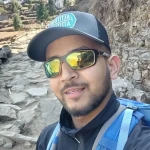


Sandip Dhungana
Nepal 🇳🇵
Whatsapp: +977-9823636377
Speak to an Expert





Sandip Dhungana
Nepal 🇳🇵
Whatsapp: +977-9823636377


